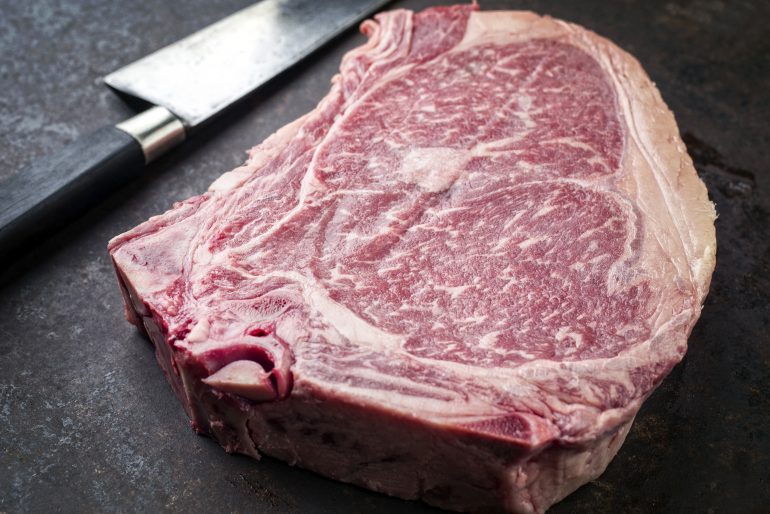EXPANDING THE GOTHAM STEAK PROGRAM
By Chip Klose
THE NEW WORLD
For many Americans, beef is at the center of celebratory dining. American beef, in particular, is known the world over, and remains a testament to our prosperity and ingenuity as a nation.
It began more than 400 years ago when Christopher Columbusbrought cattle with him to the Americas. When he discovered the island Hispaniola — Haiti, as we know it today — he and his crew disembarked and let the animals roam free. The cattle would later make their way to the North American continent when Cortéstransported them from Hispaniola to Mexico. From there, they eventually made their way up into Texas, New Mexico, California, and beyond.
With each new wave of European explorers — all of them seeking fame, fortune, and a better way of life — more cattle would arrive in the New World. The cattle population continued to grow for hundreds of years as the animals fed off the bountiful land of the Americas.
TECHNOLOGICAL INNOVATIONS
Fast forward a few centuries, and much has changed. Over the past fifty years technological advances have helped create efficiency, allowing cattlemen to increase production and lower costs. In that time Americans also discovered grain-fed beef made for a tastier version than the leaner grass-fed cattle. And so when the efficiencies of our manufacturing era were applied to cattle, the beef industry was able to expand rapidly, peaking in the 1970’s. This expansion, however, wasn't all good. Quality suffered, and it became increasingly more difficult to know #1 - where your beef came from, and #2 - the manner in which it was raised. By the mid-70's American beef was almost exclusively corn fed, and because of that, issued a steady diet of antibiotics and hormones.
TURNING THE PAGE
Though all looked bleak, there was a small group of dedicated farmers intent on rolling back the clock. In the 1980’s Bill Nimanfound himself at the center of a revolution in the way America produced food. Specifically, when it came to the way cattle was raised. Bill Niman, of course, is the founder of Niman Ranch, an extraordinary organization with whom we proudly partner here at Gotham. But thirty years ago — just as Gotham was not yet a household name — neither was Niman Ranch.
ADDRESSING THE PROBLEM
In order to solve the problem, Bill knew he had to acknowledge that there was one. (We’ve written about this before, and we invite you to read HERE and HERE.)As America’s food production became more and more industrialized through the 50’s, 60’s, and 70’s, Niman and his team knew something was being lost. What though? Taste? Quality? Ethics? Or perhaps something greater?
To begin, they set out to answer one key question: What makes a great steak?
Their answer came back in three parts: breeding, feeding, and proper handling of the beef from aging to roasting.
GOTHAM’S PERSPECTIVE
“We’ve always known our steak program was special,” says Gotham’s Managing Partner, Bret Csencsitz. “In fact, I am convinced we serve the best steaks in New York. We start with a great product -- beef that is raised naturally without antibiotics or hormones -- and then work hand-in-hand with our partners at Debragga & Spitler, who age all of the cuts to our specifications. From there, of course, we cook it to perfection.”
At Gotham nearly all of our beef is dry-aged, and that’s because Chef de Cuisine and head-butcher, Livio Velardo, is a big advocate for what the aging process does to the flavor of a great steak. Our signature cut, the famous NY Steak, is aged 28 days, while many of our specialty cuts are aged even longer. (Some as much as 50-60 days)
Velardo explains, “The aging process is where much of the magic happens with flavor. The mineralization and micro-biotic activity creates a depth of flavor that elevates the steak to new heights.”
It’s both time-intensive and expensive, but the result provides all the proof we need.
EXPANDING THE STEAK PROGRAM
Back in October we unveiled our new Fall Menu, announcing (among other things) an expansion of the Gotham Steak Program. Of course, the restaurant has become famous for Chef Alfred Portale’s 28-Day Dry Aged NY Steak, but (as many of our patrons know) for the past ten years we’ve also partnered with Niman Ranch to offer a variety of premium cuts to complement that signature offering.
As the team began imagining what the new menu might look like, the chefs were unanimous in their desire to broaden the variety of cuts offered each night. With the help of Marc Sarrazin(President & CEO of Debragga & Spitler), we started outlining a path that would get us there. Marc and his son, Eric, pulled together a short list for us, and by the end of that week we were tasting our way through an extraordinary lineup of cuts from all over the country.
Over the past few months we’ve been able to offer our guests more of these premium cuts including a 40-Day Dry Aged Bone-In Strip, a 60-Day Dry Aged Côte de Boeuf, a Porterhouse for Two (all from Niman Ranch), as well as a variety of Wagyu steaks from Imperial Farmsin Omaha, Nebraska. In time, we also hope to offer our guests interesting cuts from upstate New York as we continue to build relationships with ranchers who can deliver the kind of quality our guests demand.
COCKTAIL RECIPE: Port Side Flip
December 12, 2018



